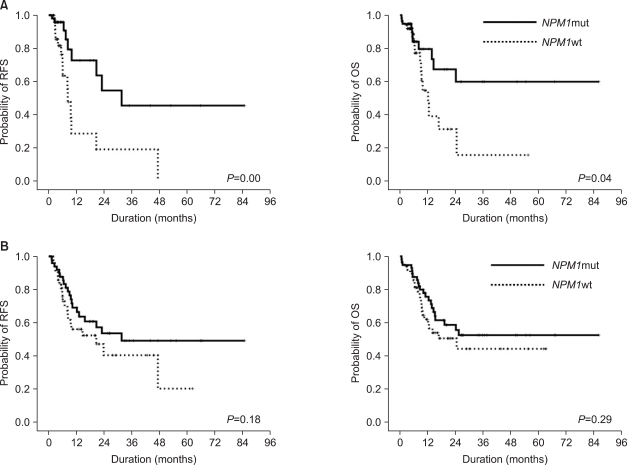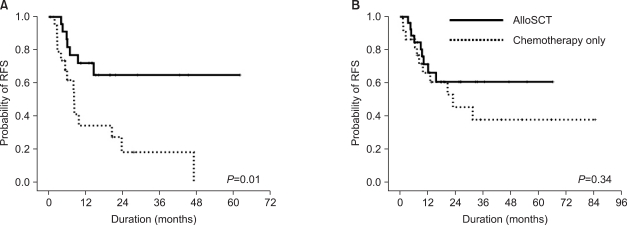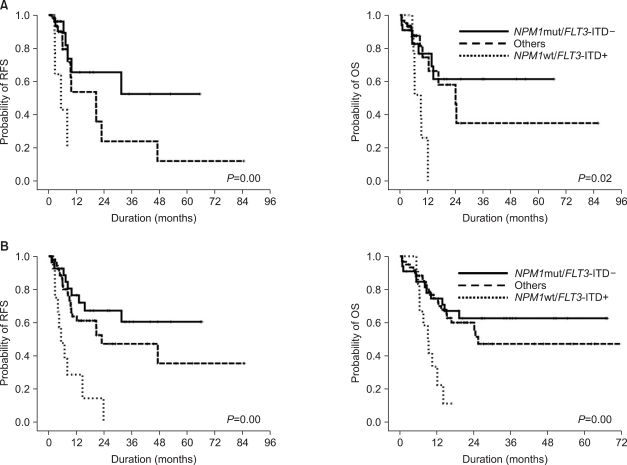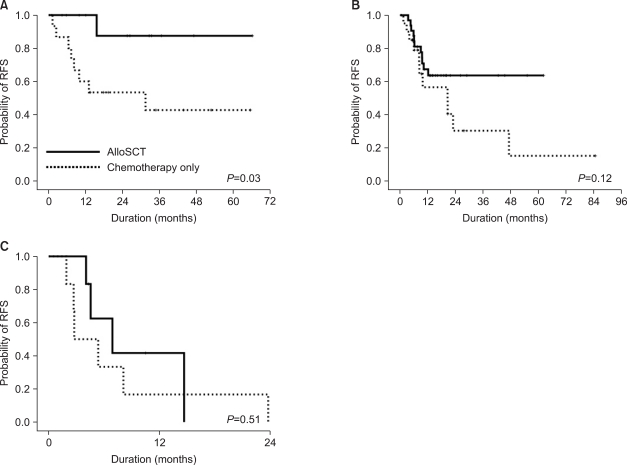Prognostic significance of nucleophosmin mutations and FLT3 internal tandem duplication in adult patients with cytogenetically normal acute myeloid leukemia
- Affiliations
-
- 1Department of Hematology/Oncology, Research Institute of Medical Sciences, Chonnam National University Medical School, Gwangju, Korea.
- 2Genome Research Center for Hematopoietic Diseases, Chonnam National University Hwasun Hospital, Hwasun, Korea.
- 3Department of Hematology/Oncology, Korea University Anam Hospital, Seoul, Korea.
- 4Department of Laboratory Medicine, Chonnam National University Medical School, Gwangju, Korea.
- KMID: 2252083
- DOI: http://doi.org/10.5045/kjh.2010.45.1.36
Abstract
- BACKGROUND
Nucleophosmin (NPM1) gene and fms-like tyrosine kinase 3 gene-internal tandem duplication (FLT3-ITD) mutations are the most frequent mutations in patients with cytogenetically normal (CN)-AML. We analyzed the prognostic impact of these mutations and their interactions in adults with CN-AML.
METHODS
NPM1 mutation (NPM1mut) and FLT3-ITD mutation (FLT3-ITD+) were analyzed by GeneScan and PCR assays of bone marrow samples obtained from 121 adult patients with CN-AML (age< or =60 years at diagnosis).
RESULTS
The incidence of FLT3-ITD+ was higher in the NPM1mut group than in the wild-type NPM1 gene (NPM1wt) group. The patients were divided according to their mutation status into the NPM1mut/FLT3-ITD (isolated NPM1mut), NPM1mut/FLT3-ITD+ or NPM1wt/FLT3-ITD-, and NPM1wt/FLT3-ITD+ (isolated FLT3-ITD+) groups. The isolated NPM1mut group showed significantly better clinical outcomes in terms of relapse rate, 5-year relapse-free survival (RFS), and overall survival (OS) than the other groups. In contrast, the isolated FLT3-ITD+ group had a higher relapse rate and shorter RFS and OS than the other groups. The 5-year RFS rate was much higher among the patients who underwent allogeneic stem cell transplantation (alloSCT) than among those treated with high-dose cytarabine chemotherapy (HDAC) only as consolidation therapy in the isolated NPM1mut group and the NPM1mut/FLT3-ITD+ or NPM1wt/FLT3-ITD- group.
CONCLUSION
Adult patients with CN-AML carrying isolated NPM1mut and isolated FLT3-ITD+ exhibit different clinical outcomes than those with NPM1mut/FLT3-ITD+ or NPM1wt/FLT3-ITD-. Although isolated NPM1mut leads to favorable clinical outcomes of CN-AML, the role of alloSCT in such patients remains to be considered.
Keyword
MeSH Terms
Figure
Cited by 3 articles
-
Identification of Two Novel
NPM1 Mutations in Patients with Acute Myeloid Leukemia
Yongbum Jeon, Sang Won Seo, Seonyang Park, Seungman Park, So Yeon Kim, Eun Kyung Ra, Sung Sup Park, Moon-Woo Seong
Ann Lab Med. 2013;33(1):60-64. doi: 10.3343/alm.2013.33.1.60.Mutations in AML with a normal karyotype:
NPM1 andFLT3 -ITD, ready to use as a key prognosticator?
Hee-Je Kim
Korean J Hematol. 2010;45(2):79-80. doi: 10.5045/kjh.2010.45.2.79.Prognostic significance of the
FLT3 ITD mutation in patients with normal-karyotype acute myeloid leukemia in relapse
Sang Hyuk Park, Hyun-Sook Chi, Sook-Kyung Min, Young-Uk Cho, Seongsoo Jang, Chan-Jeoung Park, Jung-Hee Lee, Je-Hwan Lee, Kyoo-Hyung Lee, Ho-Joon Im, Jong-Jin Seo
Korean J Hematol. 2011;46(2):88-95. doi: 10.5045/kjh.2011.46.2.88.
Reference
-
1. Mrózek K, Heinonen K, Bloomfield CD. Clinical importance of cytogenetics in acute myeloid leukaemia. Best Pract Res Clin Haematol. 2001; 14:19–47. PMID: 11355922.
Article2. Slovak ML, Kopecky KJ, Cassileth PA, et al. Karyotypic analysis predicts outcome of preremission and postremission therapy in adult acute myeloid leukemia: a Southwest Oncology Group/Eastern Cooperative Oncology Group Study. Blood. 2000; 96:4075–4083. PMID: 11110676.
Article3. Szebeni A, Olson MO. Nucleolar protein B23 has molecular chaperone activities. Protein Sci. 1999; 8:905–912. PMID: 10211837.
Article4. Lee SY, Park JH, Kim S, Park EJ, Yun Y, Kwon J. A proteomics approach for the identification of nucleophosmin and heterogeneous nuclear ribonucleoprotein C1/C2 as chromatin-binding proteins in response to DNA double-strand breaks. Biochem J. 2005; 388:7–15. PMID: 15737070.
Article5. Colombo E, Marine JC, Danovi D, Falini B, Pelicci PG. Nucleophosmin regulates the stability and transcriptional activity of p53. Nat Cell Biol. 2002; 4:529–533. PMID: 12080348.
Article6. Bertwistle D, Sugimoto M, Sherr CJ. Physical and functional interactions of the Arf tumor suppressor protein with nucleophosmin/B23. Mol Cell Biol. 2004; 24:985–996. PMID: 14729947.
Article7. Falini B, Bolli N, Shan J, et al. Both carboxy-terminus NES motif and mutated tryptophan(s) are crucial for aberrant nuclear export of nucleophosmin leukemic mutants in NPMc+ AML. Blood. 2006; 107:4514–4523. PMID: 16455950.
Article8. Falini B, Nicoletti I, Martelli MF, Mecucci C. Acute myeloid leukemia carrying cytoplasmic/mutated nucleophosmin (NPMc+ AML): biologic and clinical features. Blood. 2007; 109:874–885. PMID: 17008539.
Article9. Thiede C, Koch S, Creutzig E, et al. Prevalence and prognostic impact of NPM1 mutations in 1485 adult patients with acute myeloid leukemia (AML). Blood. 2006; 107:4011–4020. PMID: 16455956.10. Falini B, Mecucci C, Tiacci E, et al. Cytoplasmic nucleophosmin in acute myelogenous leukemia with a normal karyotype. N Engl J Med. 2005; 352:254–266. PMID: 15659725.
Article11. Döhner K, Schlenk RF, Habdank M, et al. Mutant nucleophosmin (NPM1) predicts favorable prognosis in younger adults with acute myeloid leukemia and normal cytogenetics: interaction with other gene mutations. Blood. 2005; 106:3740–3746. PMID: 16051734.12. Gale RE, Green C, Allen C, et al. The impact of FLT3 internal tandem duplication mutant level, number, size, and interaction with NPM1 mutations in a large cohort of young adult patients with acute myeloid leukemia. Blood. 2008; 111:2776–2784. PMID: 17957027.13. Rosnet O, Schiff C, Pébusque MJ, et al. Human FLT3/FLK2 gene: cDNA cloning and expression in hematopoietic cells. Blood. 1993; 82:1110–1119. PMID: 8394751.14. Kottaridis PD, Gale RE, Frew ME, et al. The presence of a FLT3 internal tandem duplication in patients with acute myeloid leukemia (AML) adds important prognostic information to cytogenetic risk group and response to the first cycle of chemotherapy: analysis of 854 patients from the United Kingdom Medical Research Council AML 10 and 12 trials. Blood. 2001; 98:1752–1759. PMID: 11535508.15. National Comprehensive Cancer Network. Version 2. 2010. Accessed January 8, 2010. at http://www.nccn.org/professionals/physician_gls/PDF/aml.pdf.16. Brown P, McIntyre E, Rau R, et al. The incidence and clinical significance of nucleophosmin mutations in childhood AML. Blood. 2007; 110:979–985. PMID: 17440048.
Article17. Hollink IH, Zwaan CM, Zimmermann M, et al. Favorable prognostic impact of NPM1 gene mutations in childhood acute myeloid leukemia, with emphasis on cytogenetically normal AML. Leukemia. 2009; 23:262–270. PMID: 19020547.18. Mrózek K, Carroll AJ, Maharry K, et al. Central review of cytogenetics is necessary for cooperative group correlative and clinical studies of adult acute leukemia: the Cancer and Leukemia Group B experience. Int J Oncol. 2008; 33:239–244. PMID: 18636143.
Article19. Cheson BD, Bennett JM, Kopecky KJ, et al. Revised recommendations of the international working group for diagnosis, standardization of response criteria, treatment outcomes, and reporting standards for therapeutic trials in acute myeloid leukemia. J Clin Oncol. 2003; 21:4642–4649. PMID: 14673054.
Article20. Cilloni D, Messa F, Rosso V, et al. Increase sensitivity to chemotherapeutical agents and cytoplasmatic interaction between NPM leukemic mutant and NF-kappaB in AML carrying NPM1 mutations. Leukemia. 2008; 22:1234–1240. PMID: 18401421.21. Koh Y, Park J, Bae EK, et al. Non-A type nucleophosmin 1 gene mutation predicts poor clinical outcome in de novo adult acute myeloid leukemia: differential clinical importance of NPM1 mutation according to subtype. Int J Hematol. 2009; 90:1–5. PMID: 19484332.
Article22. Suciu S, Mandelli F, de Witte T, et al. Allogeneic compared with autologous stem cell transplantation in the treatment of patients younger than 46 years with acute myeloid leukemia (AML) in first complete remission (CR1): an intention-to-treat analysis of the EORTC/GIMEMAAML-10 trial. Blood. 2003; 102:1232–1240. PMID: 12714526.
Article23. Farag SS, Ruppert AS, Mrózek K, et al. Outcome of induction and postremission therapy in younger adults with acute myeloid leukemia with normal karyotype: a cancer and leukemia group B study. J Clin Oncol. 2005; 23:482–493. PMID: 15534356.
Article24. Bloomfield CD, Lawrence D, Byrd JC, et al. Frequency of prolonged remission duration after high-dose cytarabine intensification in acute myeloid leukemia varies by cytogenetic subtype. Cancer Res. 1998; 58:4173–4179. PMID: 9751631.25. Estey E, Döhner H. Acute myeloid leukaemia. Lancet. 2006; 368:1894–1907. PMID: 17126723.
Article26. Byrd JC, Mrózek K, Dodge RK, et al. Pretreatment cytogenetic abnormalities are predictive of induction success, cumulative incidence of relapse, and overall survival in adult patients with de novo acute myeloid leukemia: results from Cancer and Leukemia Group B (CALGB 8461). Blood. 2002; 100:4325–4336. PMID: 12393746.
Article
- Full Text Links
- Actions
-
Cited
- CITED
-
- Close
- Share
- Similar articles
-
- Prognostic Significance of FLT3 Internal Tandem Duplication in Acute Myeloid Leukemia with Normal Karyotype
- Prevalence of FLT3 Internal Tandem Duplication in Adult Acute Myelogenous Leukemia
- FLT3 Internal Tandem Duplication in Acute Myeloid Leukemia with Normal Karyotype
- FLT3 mutations in acute myeloid leukemia: a review focusing on clinically applicable drugs
- FLT3 Gene Mutations as a Prognostic Factor for Acute Myeloid Leukemia





